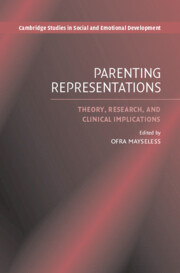Book contents
- Frontmatter
- Contents
- List of Illustrations
- List of Tables
- List of Appendixes
- List of Contributors
- Preface
- Acknowledgments
- Part One Theoretical Perspectives
- 1 Studying Parenting Representations as a Window to Parents' Internal Working Model of Caregiving
- 2 Maternal Representations of Relationships: Assessing Multiple Parenting Dimensions
- 3 Social Cognitive Approaches to Parenting Representations
- Part Two Research Applications
- Part Three Clinical Implications
- Index
- Cambridge Studies in Social and Emotional Development
- References
1 - Studying Parenting Representations as a Window to Parents' Internal Working Model of Caregiving
from Part One - Theoretical Perspectives
Published online by Cambridge University Press: 10 July 2009
- Frontmatter
- Contents
- List of Illustrations
- List of Tables
- List of Appendixes
- List of Contributors
- Preface
- Acknowledgments
- Part One Theoretical Perspectives
- 1 Studying Parenting Representations as a Window to Parents' Internal Working Model of Caregiving
- 2 Maternal Representations of Relationships: Assessing Multiple Parenting Dimensions
- 3 Social Cognitive Approaches to Parenting Representations
- Part Two Research Applications
- Part Three Clinical Implications
- Index
- Cambridge Studies in Social and Emotional Development
- References
Summary
Abstract
This chapter examines the concept of parenting representations as embedded in the conceptualization of attachment theory regarding the caregiving behavioral system. The growing body of research on parenting representations is extensively reviewed, and the notion of “internal working model of caregiving” is presented in relation to the extant literature. In general, strong reliability and validity of various schemes for coding interviews assessing parenting representations are demonstrated, and their distinctiveness with regards to state of mind with respect to attachment is noted. The implications of this research and the concept of Internal Working Models (IWM) of caregiving are discussed, and future directions for theory and research are suggested.
Historical Overview
What's on a Parent's Mind
The study of parenting has a long history in clinical and developmental psychology. For the most part, researchers treated parents as the independent variable and were interested in them insomuch as they affected the normal or pathological development of children. The interest in the parent, in most cases the mother, as a subject in and of itself, and the focus on the parent's own desires, wishes, thoughts, and affective world, has developed mostly in the last two decades. Four major fields of research displayed such a focus: (1) researchers in the psychoanalytic tradition (e.g., Kraemer, 1996; Stern, 1989; Stern-Bruschweiler & Stern, 1989; see a review in Wiseman, Hashmonay, & Harel, this volume), (2) scholars of a feminist outlook (e.g., Ruddick, 1989), (3) researchers taking the social cognition perspective in developmental psychology (see a review in Rudy & Grusec, this volume), and (4) scholars in the tradition of attachment theory.
- Type
- Chapter
- Information
- Parenting RepresentationsTheory, Research, and Clinical Implications, pp. 3 - 40Publisher: Cambridge University PressPrint publication year: 2006
References
- 20
- Cited by



